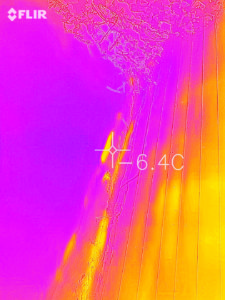
Air infiltration at outlet. Blue is colder area indicating air coming from outside. Courtesy photos.
Michael Canavan
I received a call from a homeowner saying they had a blower door test done to find out how well their house was sealed against drafts. They were looking for any places that air could be leaking in or out of the house.
They described the house as a two-story colonial built in 2004. It was assembled on site from four prefabricated units, two for each floor, on a concrete foundation. It had all the windows and building wrap on the exterior when it arrived on site, the roof system and vinyl siding were installed on site after the sections were assembled.
The homeowner had a blower door test on their house but was not sure how to interpret the results of the test. The report indicated an AHC50 of 8. As it was October, cooler air was being sucked into the house, so during testing the technician used an infrared (IR) camera to look for cold spots. He also had a smoke-generating pen looking for locations of air infiltrating drafts, outlets, switches, pipes, and vents.
First, the blower door test uses a calibrated fan to blow air making a pressure difference between the inside and outside of the house that forces air through all the holes in the building envelope. The fewer the holes the less air you need to change the pressure.
Now, what does ACH50 mean? It is simply the number of times the air will change over in an hour, in a house with an air pressure of 50 pascals applied to all sides of it. What is “50 pascals?” It is air pressure equal to a 20mph wind on your house which is the standard set by the International Energy Conservation Code (IECC). The IECC developed this kind of measurement, so that all houses are tested using the same procedures. They set a requirement in 2009 that houses should be built to at most an ACH50 of 7. This was revised in 2012 to an ACH50 of 5 or 3 depending upon which climate zone you’re in. Vermont, New Hampshire, New York, Massachusetts, and Maine are an ACH50-of-3 climate zone. This standard was aimed at improving air barrier systems for buildings, which means fewer home air changes and lower heating and cooling costs. It is succeeding, as builders are now more educated in how to seal a building better than just a few years ago.
Back to the question, for the house with an ACH50 of 8 this means the air in your house is completely replaced eight times in one hour when the wind is blowing at 20mph. That means you’re using more energy for heating and cooling than you should. With the test report, you should receive pictures of areas where warm air is escaping the house. Some of these spots are easy to seal. For example, you can retain more heat by adding outlet foam sealers on the inside of the cover plate, insulation on the bathroom exhaust vents, and new weather stripping on doors and windows.
When you finish doing all the items recommended in the report, you may save over 10% on your heating and cooling costs. If your house is older and leakier, you can potentially save up to 35% of your heating cost. On a heating bill of $3800 that’s $1330! — a good deal! Perhaps more important, your home will be more comfortable when it is warmer with no drafts due to the reduced air infiltration potential. Your heating equipment will have a longer lifetime due to reduced loads. You can look forward to being in your cozy, warm house this winter as the blizzards rage outside this year.
Michael Canavan is the owner of Eagle Home Inspection Solutions of Norwich, Vermont. Learn more at www.EagleHomeInspectionSolutions.com or (802)526-2642.









Leave a Reply